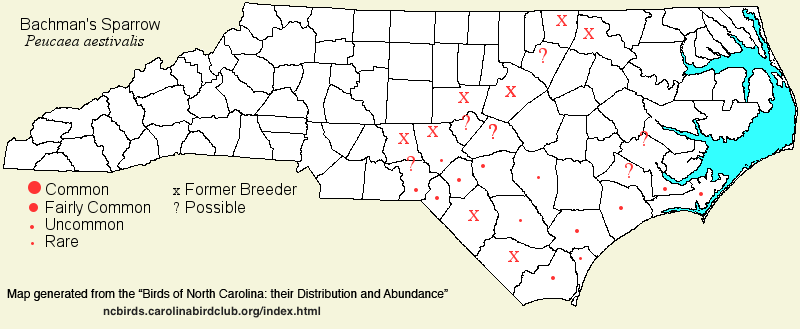 |  |
|
Bachman's Sparrow - Peucaea aestivalis PASSERELLIDAE Members: | Search Common: Search Scientific: |
|
|
|||||||
| General Comments | The Bachman's Sparrow is a rare and strongly declining species over its entire range. It nests only in the southeastern portion of the United States, and its range has shrunk considerably over the past 50-75 years. Though long known primarily as a bird of open Longleaf Pine or Slash Pine stands, formerly it occurred into the southern portions of the Midwestern states. It nested in the eastern Piedmont of North Carolina into the mid-1990's, but it apparently now is essentially limited to the Longleaf Pine areas in the state, both coastally and in the Sandhills. Thankfully, it takes well to management, and prescribed burning of these pine stands produces flowering and fruiting by Wiregrass, essential for both food and cover (especially in winter). It does winter over much of the breeding range, but it is quite secretive at that season. Fire suppression, conversion of Longleaf Pine stands to Loblolly Pine plantations, pine straw raking, and development have meant that probably 95% or more of the Bachman's Sparrows now reside on managed conservation lands. Favored habitats must have dense grassy cover, preferably Wiregrass, with few shrubs, but with scattered middle-aged to mature Longleaf Pines (for singing perches); however, the birds forage in heavy cover of grasses and can be difficult to see unless/until flushed into a shrub or tree. | ||||||
| Breeding Status | Breeder | ||||||
| NC BRC List | Definitive | ||||||
| State Status | SC | ||||||
| U.S. Status | |||||||
| State Rank | S3B,S2N | ||||||
| Global Rank | G3 | ||||||
| Coastal Plain | Scarce permanent resident, but with migratory movements. In summer, locally fairly common near the southern coast (from Croatan National Forest southward), but highly restricted to managed Longleaf Pine stands -- e.g., Croatan NF, Camp Lejeune, and Holly Shelter Game Land. Also, locally fairly common in the Sandhills, but mainly at Fort Bragg and Sandhills Game Land; rare to uncommon elsewhere in the Sandhills, and now very rare between the Sandhills and the lower Coastal Plain. In Jun-Jul 2024 two were singing at one Bladen site and another was singing a few miles away, to establish at least some presence in this general gap in the range. Absent farther northward. In winter, occurs within this same range, but apparently uncommon; however, as it is very secretive until late Feb, wintering population abundance is not well known. Peak counts: about 70 singing males at Holly Shelter Game Land in 1995; about 55 birds on territory at Camp Lejeune in 1991. Winter peak counts: 12, Camp Lejeune CBC (Onslow), 18 Dec 2014; 11 on that same count, 20 Dec 2013. | ||||||
| Piedmont | Former summer resident in a portion of the region; probably now absent. Prior to 1942, it nested in the "central" part of the state, and a nest was found at Guilford College (Guilford). In the past few decades, it was rare and local in summer along the extreme eastern edge (Halifax, Warren, Wake, Chatham, Moore) of the province, until about 1997. Nesting habitats were overgrown fields/clearcuts, especially where there was dense grass cover. Away from this narrow area, accidental or casual visitor. Mainly early Apr into Sep (but departure dates speculative); no winter records. Peak counts: 13, Merry Oaks (Chatham), 18 Jul 1993. | ||||||
| Mountains | Accidental. Historical records from Buncombe and Macon. | ||||||
| Finding Tips |
The species is still easily found from Mar into about Jul in Holly Shelter Game Land (along Lodge Road and Tram Road in the southern portion of the game land) and along Millis Road in Croatan National Forest. You should be able to find a few at that time of year in the Sandhills Game Land, but the lower Coastal Plain is better. As singing males often perch on bare stubs on the lower and middle portions of the pines, they can often be easily spotted at some distance; however, through binoculars a bird looks like a brown spot, and thus it is recommended to carry a scope in order to see the bird's fine details well. *** | ||||||
| Attribution | LeGrand[2024-11-07], LeGrand[2023-03-31], LeGrand[2018-12-19] | ||||||
| NC Map Map depicts all counties with a report (transient or resident) for the species. | Click on county for list of all known species. |
| NC Breeding Season Map Map depicts assumed breeding season abundance for the species. |  |